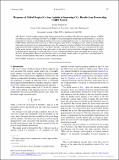Response of Global Tropical Cyclone Activity to Increasing CO2: Results from Downscaling CMIP6 Models
Author(s)
Emanuel, Kerry Andrew
DownloadPublished version (1.935Mb)
Publisher Policy
Publisher Policy
Article is made available in accordance with the publisher's policy and may be subject to US copyright law. Please refer to the publisher's site for terms of use.
Terms of use
Metadata
Show full item recordAbstract
© 2020 American Meteorological Society. For information regarding reuse of this content and general copyright information, consult the AMS Copyright Policy (www.ametsoc.org/PUBSReuseLicenses). Global models comprising the sixth-generation Coupled Climate Model Intercomparison Project (CMIP6) are downscaled using a very high-resolution but simplified coupled atmosphere-ocean tropical cyclone model, as a means of estimating the response of global tropical cyclone activity to increasing greenhouse gases. As with a previous downscaling of CMIP5 models, the results show an increase in both the frequency and severity of tropical cyclones, robust across the models downscaled, in response to increasing greenhouse gases. The increase is strongly weighted to the Northern Hemisphere, and especially noteworthy is a large increase in the higher latitudes of the North Atlantic. Changes are insignificant in the South Pacific across metrics. Although the largest increases in track density are far from land, substantial increases in global landfalling power dissipation are indicated. The incidence of rapid intensification increases rapidly with warming, as predicted by existing theory. Measures of robustness across downscaled climate models are presented, and comparisons to tropical cyclones explicitly simulated in climate models are discussed.
Date issued
2021Department
Lorenz Center (Massachusetts Institute of Technology)Journal
Journal of Climate
Publisher
American Meteorological Society